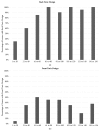Practitioner Learning Curve in Fitting Scleral Lenses in Irregular and Regular Corneas Using a Fitting Trial
- PMID: 30834269
- PMCID: PMC6369499
- DOI: 10.1155/2019/5737124
Practitioner Learning Curve in Fitting Scleral Lenses in Irregular and Regular Corneas Using a Fitting Trial
Abstract
Purpose: To assess the learning curve of a novel practitioner with minor previous experience with scleral lenses (SL) fitting in the initial 156 consecutive fittings in irregular and regular corneas using a fitting trial.
Methods: Prospective dispensing case series involving a total of 85 subjects (156 eyes), 122 eyes with irregular corneas (IC Group) and 34 eyes with regular corneas (RC Group). All lenses were fitted by the same practitioner with minimal previous knowledge and practice on SL fitting. The first 156 consecutive fits were studied to estimate the number of trial lenses required to achieve the optimal fit and the number of reorders required. The results were divided into 8 chronological groups of 20 fittings (eyes) each.
Results: There was a decrease in the number of trial lenses required to achieve the optimal fit from 2.35±0.18 lenses in the first 20 fittings to 1.56±0.13 in the last fittings (p<0.05, Wilcoxon). There were no statistically significant differences between IC and RC groups. Regarding the number of reorders, there was also a decrease from 0.95±0.17 in the first fittings to 0.25±0.11 in the last fittings (p<0.05, Wilcoxon). Thought not statistically significant, there was an increase in the use of toric designs with increasing experience.
Conclusions: Practitioner fitting experience reduced both the number of trial lenses required to achieve the best fit and the number of reorders with time. After the first 60 cases, there was a significant reduction in the trial lenses and reorders necessity.
Figures



Similar articles
-
Relationship of placido corneal topography data with scleral lens fitting parameters.Cont Lens Anterior Eye. 2019 Feb;42(1):20-27. doi: 10.1016/j.clae.2018.07.005. Epub 2018 Jul 25. Cont Lens Anterior Eye. 2019. PMID: 30055934
-
Corneo-scleral contact lenses in an uncommon case of keratoconus with high hyperopia and astigmatism.Cont Lens Anterior Eye. 2017 Oct;40(5):351-356. doi: 10.1016/j.clae.2017.07.004. Epub 2017 Jul 13. Cont Lens Anterior Eye. 2017. PMID: 28712891
-
The use of computerized videokeratography as an aid in fitting rigid gas permeable contact lenses.Trans Am Ophthalmol Soc. 1996;94:135-43; discussion 143-5. doi: 10.1016/s0002-9394(14)70162-x. Trans Am Ophthalmol Soc. 1996. PMID: 8981693 Free PMC article.
-
Contact lens fitting in keratoconus.Compr Ophthalmol Update. 2006 Mar-Apr;7(2):47-52. Compr Ophthalmol Update. 2006. PMID: 16709339 Review.
-
Fitting Scleral Lenses Less Than 15 mm in Diameter: A Review of the Literature.Eye Contact Lens. 2020 Mar;46(2):63-69. doi: 10.1097/ICL.0000000000000647. Eye Contact Lens. 2020. PMID: 31436759 Review.
Cited by
-
Image- and Impression-Based Technology in Scleral Lens Fitting for Keratoconus: Availability and Utilization.Eye Contact Lens. 2024 Jul 1;50(7):292-296. doi: 10.1097/ICL.0000000000001100. Epub 2024 May 29. Eye Contact Lens. 2024. PMID: 39078501 Free PMC article.
-
How Can We Best Measure the Performance of Scleral Lenses? Current Insights.Clin Optom (Auckl). 2022 Apr 7;14:47-65. doi: 10.2147/OPTO.S284632. eCollection 2022. Clin Optom (Auckl). 2022. PMID: 35418790 Free PMC article. Review.
-
Graduating optometry student perceptions of their scleral lens fitting knowledge.Optom Educ. 2023 Summer;48(3):27-30. Optom Educ. 2023. PMID: 37655307 Free PMC article.
References
-
- Severinsky B., Millodot M. Current applications and efficacy of scleral contact lenses — a retrospective study. Journal of Optometry. 2010;3(3):158–163. doi: 10.1016/S1888-4296(10)70022-4. - DOI
MeSH terms
LinkOut - more resources
Full Text Sources

